2017 MERCEDES-BENZ G-Class tire pressure
[x] Cancel search: tire pressurePage 261 of 286

displayed after drivingafew minutesmessage appears.
After ateach-in process, the tire pressure mon-
itor automaticallyd etects new wheels or new
sensors. As long as aclear allocation of the tire
pressure value to the individual wheels is not
possible,t heTire
PressureMonitorActivedisplaym essage is shown instead of the tire
pressure display. The tire pressures are already
being monitored.
If as pare wheel is mounted, the system may
continue to show the tire pressure of the wheel
that has been removed for afew minutes. If this
occurs, note that the value displayed for the
position where the spare wheel is installed is not
the same as the current tire pressure of the
spare wheel.
Tire pressure monitor warning mes-
sages
If the tire pressure monitor detects apressure
loss in one or more tires, awarning message is
shown in the multifunction display. The yellow
h tire pressure warning lamp then lights up.
RIf the Correct Tire Pressuremessage
appears in the multifunction display, the tire
pressure in at least one tire is too low. The tire
pressure must be corrected at the next oppor-
tunity.
RIf the Check Tiresmessage appears in the
multifunction display, the tire pressure in at
least one tire has dropped significantly. The
tires must be checked.
RIf the Caution -Tire Malfunc.message
appears in the multifunction display, the tire
pressure in at least one tire has dropped sud-
denly. The tires must be checked.
Be sure to observe the instructionsa nd safety
notes in the displaym essages in the "Tires" sec-
tion (
Ypage 183).
If the wheel positions on the vehicle are rotated, the tire pressures may be displayed for the
wrong positions for ashort time. This is rectified
after afew minutes of driving, and the tire pres-
sures are displayed for the correct positions.
Restarting the tire pressure monitor
When you restart the tire pressure monitor, all
existing warning messages are deleted and the
h warning lamp goes out. The monitor uses
the currently set tire pressures as the reference
valuesf or monitoring. In most cases, the tire pressure monitor will automaticallyd
etect the
new reference valuesa fter you have changed
the tire pressure. However, you can also set ref-
erence valuesm anuallyasdescribed here. The
tire pressure monitor then monitors the new tire
pressure values.
XSet the tire pressure to the value recommen-
ded for the corresponding driving situation on
the Tire and Loading Information placard on
the B-pillar on the driver's side.
You can find more tire pressures for various
operating conditions in the tire pressure table
inside the filler flap.
Observe the information on tire pressure
when doing so (
Ypage 254).
XMake sure that the tire pressure is correct on
all four wheels.
XMake sure that the SmartKey is in position 2
in the ignition lock.
XPress the =or; button on the steering
wheel to select the Serv.menu.
XPress the9or: button to select
Tire Pressure.
XPress the abutton.
The multifunction displays hows the current
tire pressure for each tire or the Tire pres‐
surewillbedisplayedafterdrivingafew minutesmessage appears.
XPress the :button.
The UseCurrentPressuresasNewRef‐erenceValuesmessage appears in the mul-
tifunction display.
If you wish to confirm the restart:
XPress the abutton.
The TirePress.MonitorRestartedmes-
sage appears in the multifunction display.
After driving for afew minutes, the system
checks whether the current tire pressures are within the specified range. The new tire pres-
sures are then accepted as reference values
and monitored.
If you wish to cancelt he restart:
XPress the%button.
The tire pressure valuess tored at the last
restart will continue to be monitored.
Tire pressure259
Wheels and tires
Z
Page 262 of 286
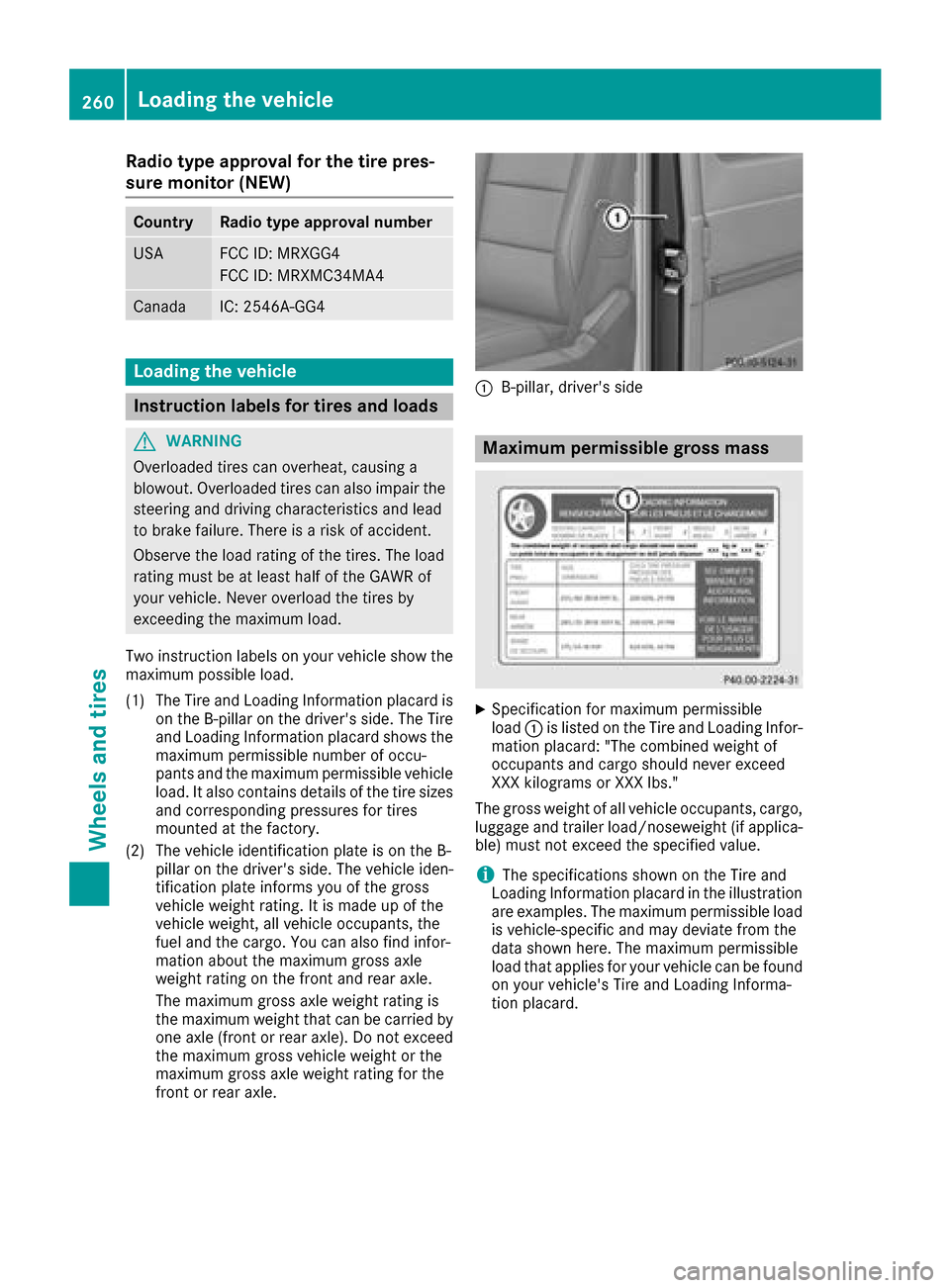
Radio type approval for the tire pres-
sure monitor(NEW)
CountryRadio type approval number
USAFCC ID: MRXGG4
FCC ID: MRXMC34MA4
CanadaIC: 2546A-GG4
Loadingthe vehicle
Instructionl abelsfor tiresa nd loads
GWARNING
Overloaded tire scan overheat, causing a
blowout. Overloaded tire scan also impai rthe
steering and driving characteristics and lead
to brake failure. There is ariskofa ccident.
Observe the load rating of the tires. The load
rating mus tbeatl easthalf of the GAW Rof
your vehicle. Nevero verload the tiresby
exceeding the maximum load.
Twoi nstruction label sonyourvehicl eshowt he
maximum possible load.
(1) The Tire and Loading Information placard is on the B-pillar on the driver'ss ide. The Tire
and Loading Information placard shows the
maximum permissible number of occu-
pants and the maximum permissible vehicle
load .Italsoc ontains detail softhe tire sizes
and corresponding pressures for tires
mounted at the factory.
(2) The vehicl eide ntification plate is on the B-
pillar on the driver'ss ide. The vehicleide n-
tification plate informs yo uofthe gross
vehicl eweigh trating. It is mad eupofthe
vehicl eweigh t, allvehicl eoccupants, the
fue land the cargo. Yo ucan also find infor-
mation aboutt he maximum gross axle
weight rating on the front and reara xle.
The maximum gross axl eweigh trating is
the maximum weight that can be carrie dby
one axl e(front or reara xle).Donot exceed
the maximum gross vehicl eweigh tort
he
ma
ximum gross axl eweigh trating for the
front or reara xle.
:B-pillar, driver'ss ide
Maximum permissibleg ross mass
XSpecification for maximum permissible
load:is listed on the Tire and Loading Infor-
mation placard: "The combine dweigh tof
occupants and carg oshoul dnevere xceed
XXX kilograms or XXX lbs."
The gross weight of al lvehicl eoccupants, cargo,
luggage and traile rload/n oseweight (i fappli ca-
ble) mus tnot excee dthe specified value.
iThe specifications shown on the Tire and
Loading Information placard in the illustration are examples. The maximum permissible load
is vehicle-specific and may deviate from the
data shown here. The maximum permissible
load that applie sfor your vehicl ecan be found
on your vehicle's Tire and Loading Informa-
tion placard.
260Loadingt he vehicle
Wheelsand tires
Page 266 of 286
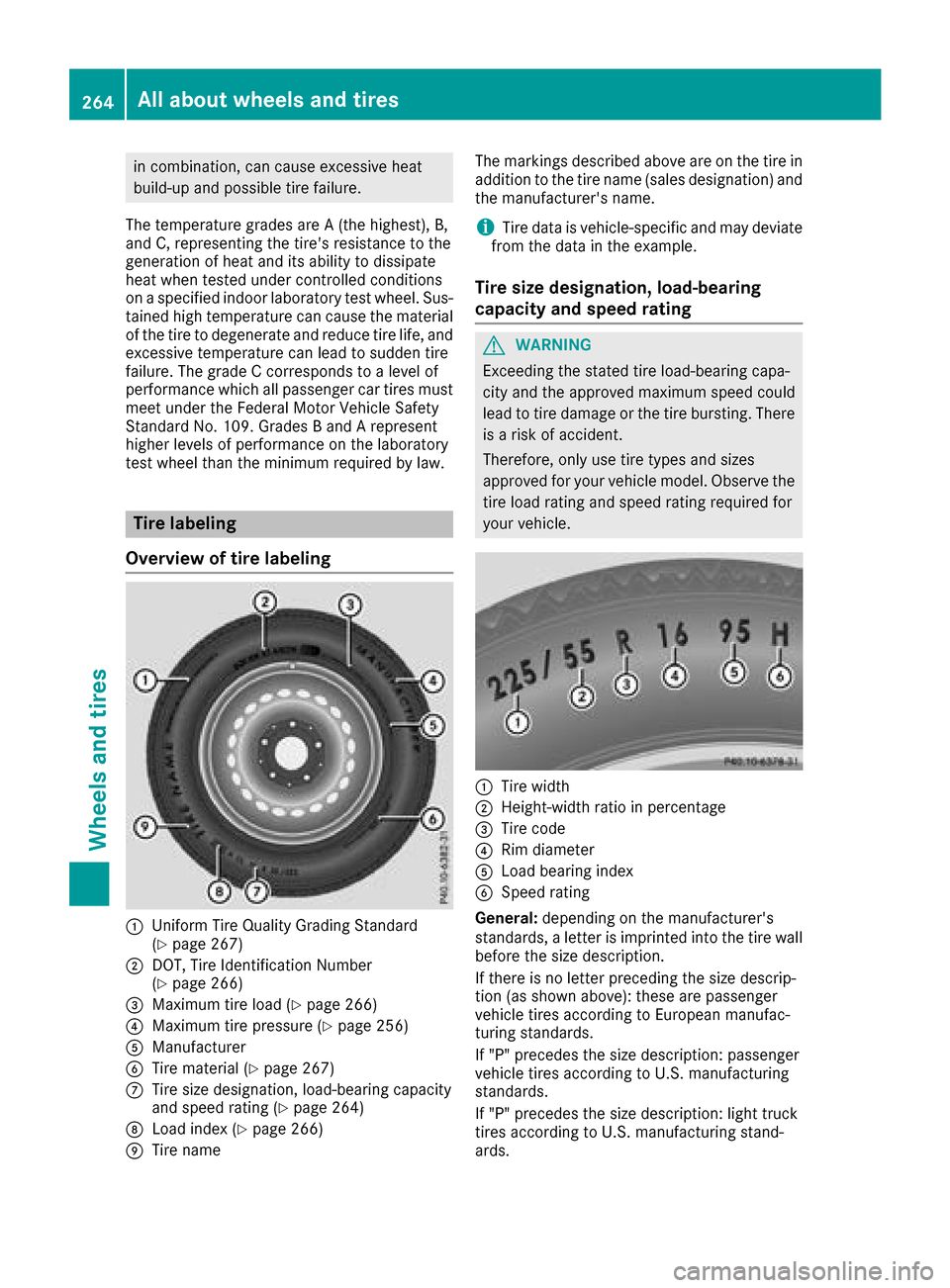
in combination, can cause excessiveheat
build-up and possible tir efailure.
The temperature grades are A(the highest), B,
and C, representin gthe tire's resistance to the
generatio nofheat and its ability to dissipate
heat when tested under controlled conditions
on aspecified indoo rlaboratory tes twheel. Sus-
tained high temperature can cause the material
of the tir etodegeneratea nd reducetirel ife, and
excessivet emperature can lead to sudden tire
failure. The grade Ccorresponds to alevel of
performance which all passenger car tires must
meet under the Federal Motor Vehicle Safety
Standard No. 109.G radesBandArepresent
higher levels of performance on the laboratory
tes twheel than the minimum requiredbyl aw.
Tirelabeling
Overview of tir elabeling
:Uniform Tire Quality Grading Standard
(Ypage 267)
;DOT ,Tire Identification Number
(Ypage 266)
=Maximum tir eload (Ypage 266)
?Maximum tir epressure (Ypage 256)
AManufacturer
BTire material (Ypage 267)
CTire size designation ,load-bearing capacity
and speed ratin g(Ypage 264)
DLoad index (Ypage 266)
ETire name The markings described above are on the tir
ein
addition to the tir ename (sales designation )and
the manufacturer'sn ame.
iTire data is vehicle-specific and may deviate
fromt he data in the example.
Tires ize designation, load-bearing
capacity and speed rating
GWARNING
Exceedin gthe stated tir eload-bearing capa-
cit ya nd the approved maximum speed could
lead to tir edamage or the tir ebursting. There
is ar isk of accident.
Therefore, only use tir etypes and sizes
approved for your vehicle model. Observe the
tir el oad ratin gand speed ratin grequiredf or
your vehicle.
:Tire width
;Height-width ratio in percentage
=Tire code
?Rim diameter
ALoad bearingi ndex
BSpeed rating
General: depending on the manufacturer's
standards, aletter is imprinted int othe tir ewall
beforet he size description.
If there is no letter preceding the size descrip-
tion (as shown above): these are passenger
vehicle tires accordingtoE uropean manufac-
turin gstandards.
If "P" precedes the size description: passenger
vehicle tires accordingtoU .S.m anufacturing
standards.
If "P" precedes the size description: light truck
tires accordingtoU .S.m anufacturing stand-
ards.
264All about wheels and tires
Wheels and tires
Page 267 of 286
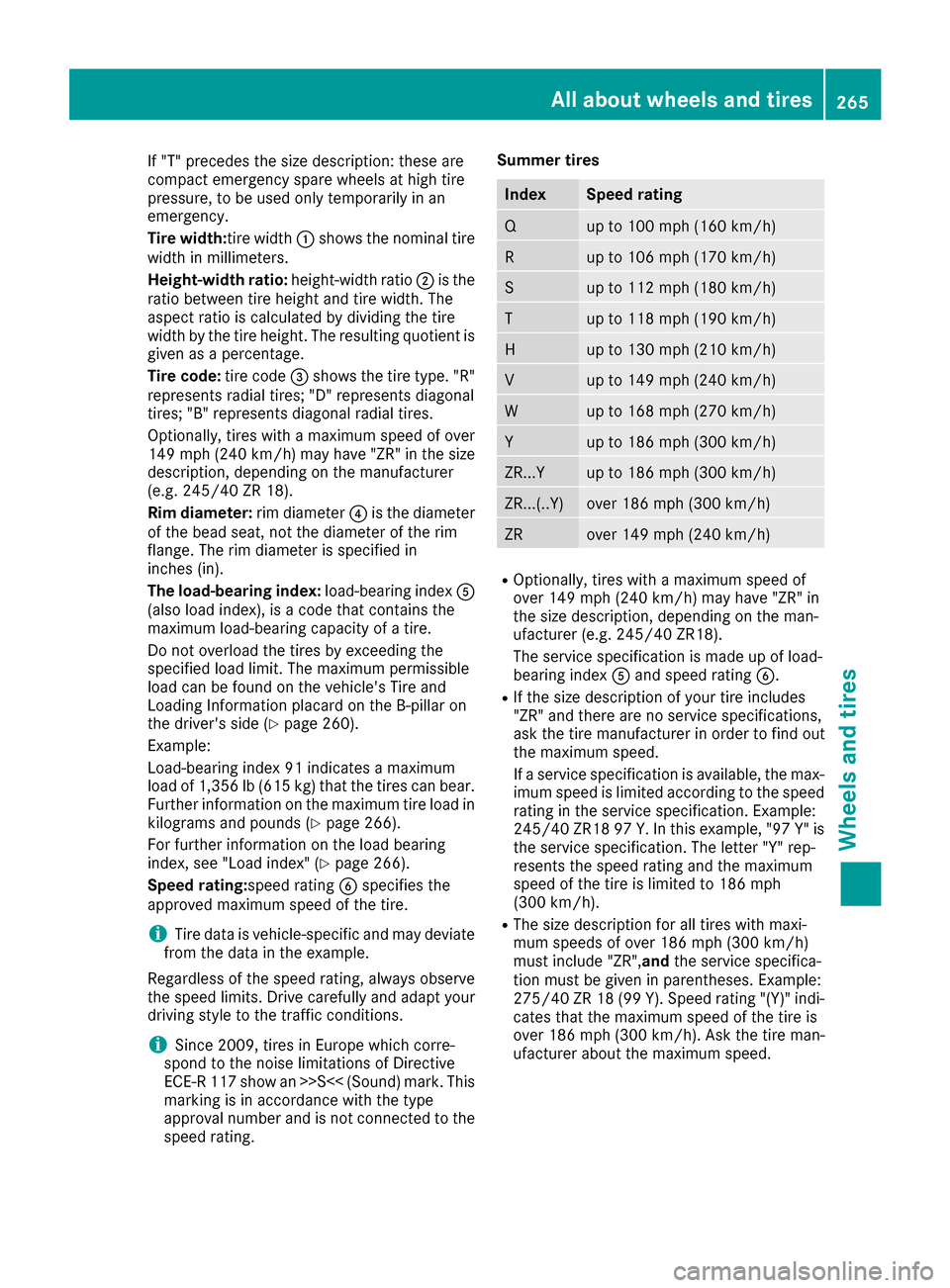
If "T" precedes the size description: these are
compact emergency spare wheelsathigh tire
pressure, to be used only temporarilyina n
emergency.
Tire width:tire width :shows the nominal tire
width in millimeters.
Height-width ratio: height-width ratio;is the
ratio between tire height and tire width. The
aspect ratio is calculated by dividing the tire
width by the tire height. The resulting quotient is
given as apercentage.
Tire code: tire code=shows the tire type. "R"
represents radial tires; "D" represents diagonal
tires; "B" represents diagonal radial tires.
Optionally, tires with amaximum speed of over
149 mph (240 km/h )may have "ZR "inthe size
description, depending on the manufacturer
(e.g. 245/40 ZR 18).
Rim diameter: rim diameter?is the diameter
of the bead seat, not the diameter of the rim
flange. The rim diameter is specifiedi n
inches (in).
The load-bearingi ndex:load-bearing index A
(also load index), is acode that contains the
maximum load-bearing capacity of atire.
Do not overloadt he tires by exceeding the
specifiedl oad limit. The maximum permissible
load can be found on the vehicle's Tire and
Loading Information placard on the B-pillaro n
the driver's side (
Ypage 260).
Example:
Load-bearing index 91 indicates amaximum
load of 1,356 lb (615 kg) that the tires can bear.
Further information on the maximum tire load in
kilograms and pounds (
Ypage 266).
For further information on the load bearing
index, see "Loadi ndex" (
Ypage 266).
Speed rating:speed rating Bspecifiest he
approved maximum speed of the tire.
iTire data is vehicle-specific and may deviate
from the data in the example.
Regardless of the speed rating, always observe
the speed limits. Drive carefully and adapt your driving style to the traffic conditions.
iSince 2009, tires in Europe which corre-
spond to the noise limitations of Directive
ECE-R 117 show an >>S<< (Sound) mark. This
marking is in accordance with the type
approval number and is not connected to the
speed ra
ting. Summer tires
IndexSpeed rating
Qup to 100 mph (160 km/h)
Rup to 106 mph (170 km/h)
Sup to 112 mph (180 km/h)
Tup to 118 mph (190 km/h)
Hup to 130 mph (210 km/h)
Vup to 149 mph (240 km/h)
Wup to 168 mph (270 km/h)
Yup to 186 mph (300 km/h)
ZR...Yup to 186 mph (300 km/h)
ZR...(..Y)over 186 mph (300 km/h)
ZRover 149 mph (240 km/h)
ROptionally, tires with
amaximum speed of
over 149 mph (240 km/h) may have "ZR "in
the size description, depending on the man-
ufacturer (e.g. 245/40 ZR18).
The service specification is made up of load-
bearing index Aand speed rating B.
RIf the size descriptionofy ourtire includes
"ZR"a nd there are no service specifications,
ask the tire manufacture rinorder to find out
the maximum speed.
If as ervice specification is available, the max-
imum speed is limited according to the speed rating in the service specification. Example:
245/40 ZR18 97 Y.In this example," 97 Y" is
the service specification. The letter "Y" rep-
resents the speed rating and the maximum
speed of the tire is limited to 186 mph
(300 km/h).
RThe size descriptionf or all tires with maxi-
mum speedsofo ver 186 mph (300 km/h)
must include "ZR", andthe service specifica-
tion must be given in parentheses.E xample:
275/40 ZR 18 (99 Y) .Speed rating "(Y)" indi-
cates that the maximum speed of the tire is
over 186 mph (300 km/h). Ask the tire man-
ufacturer aboutt he maximum speed.
Allabout wheels and tires265
Wheelsa nd tires
Z
Page 268 of 286
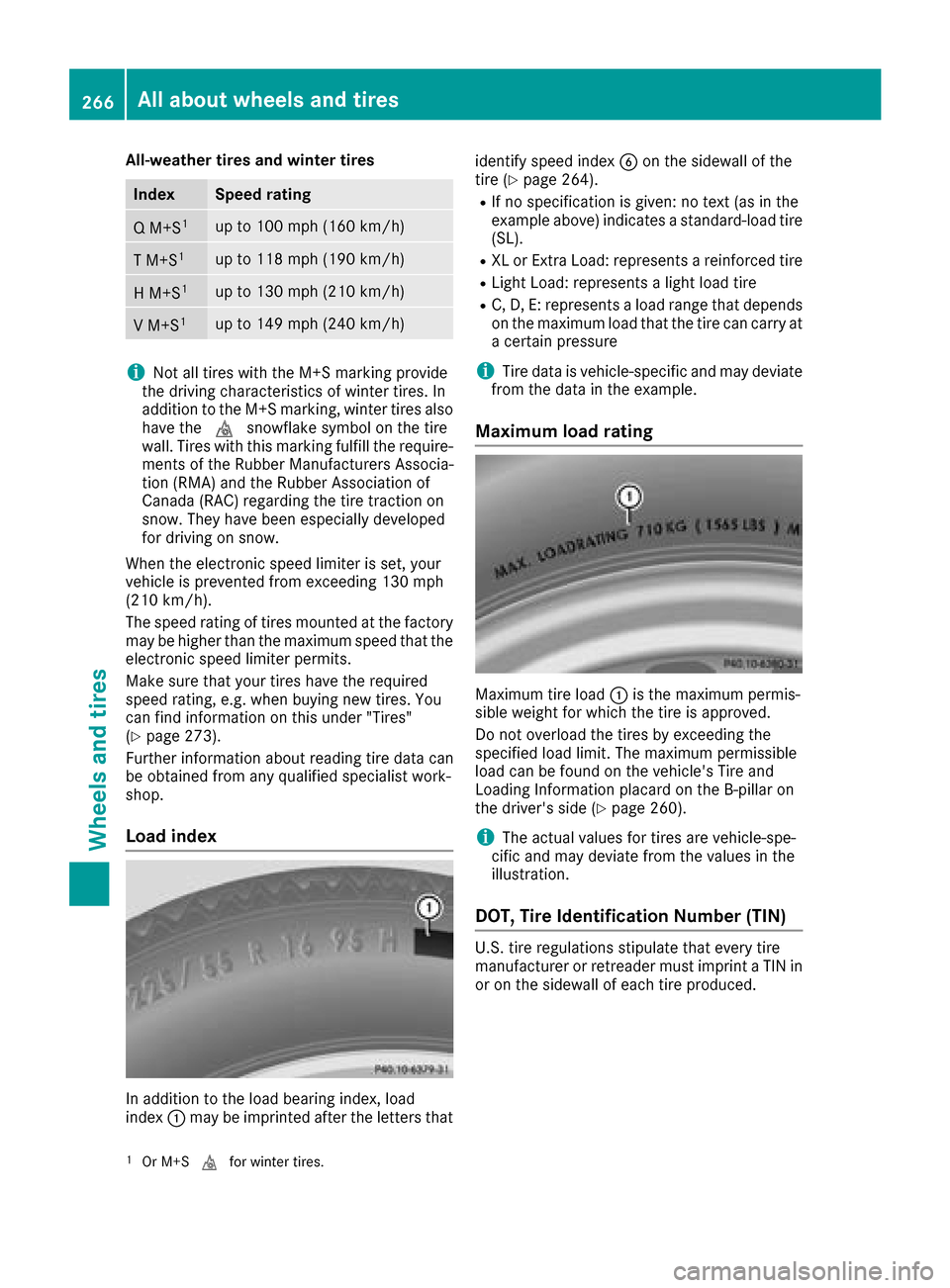
All-weather tires and winter tires
IndexSpeedrating
QM +S1up to 10 0mph(16 0km/ h)
TM +S1up to 11 8mph(19 0km/ h)
HM +S1up to 13 0mph(21 0km/ h)
VM +S1up to 14 9mph(24 0km/ h)
iNot all tires withthe M+S markin gprovide
th ed riving characteristic sofwinter tires. In
addit ion to th eM+S marking, winter tires also
have the isnowflake symbol on th etire
wall. Tireswitht hism arkin gfulf illther equire-
ments of th eRubber Manufacturers Associa-
tio n(RMA)a nd theRubber Association of
Canad a(RAC) regardin gthe tiret raction on
snow. They have been especiall ydeveloped
for driv ing on snow.
When th eelectronic speedlimiterisset,y our
veh icle is prevente dfrome xcee din g1 30 mph
(21 0km/h) .
The speedr ating of tires mounte datthefactory
may behigher than th emaximum speedt hatthe
electronic speedlimiter permits.
Makes ure that your tires have th erequired
speedr ating,e.g.w hen buyingn ewtires. You
can fin dinformatio nonthisu nde r"Tires"
(
Ypage 273).
Further informatio nabout reading tir edatac an
be obtaine dfroma nyqualif ied specialist work-
shop.
Load index
In addit ion to th eload bearing index,l oad
index :may be impr inted after th eletters that iden
tifys peedi ndexBon th esidewall of the
tir e(
Ypage 264).
RIfno specificatio nisgiven: no text (as in the
example above) indicates astandard-load tire
(SL ).
RXL or Extr aLoad :represents areinforced tire
RLightL oad:represents alight load tire
RC, D, E: represents aload range that depends
on th emaximum load that th etirec an carry at
ac ertain pressure
iTire dataisv ehicle-specific and may deviate
from th edataint heexample.
Maximum load rating
Maximum tir eload :isthem aximum permis-
sible weightf or whicht hetireisa pproved.
Do no toverload th etires by exceedingt he
specifie dload limit .The maximum permissible
load can befoun dont hevehicle's Tire and
Loading Information placard on th eB-pillar on
th ed river' sside (
Ypage 260).
iThe actual values for tires are vehicle-spe-
cif icand may deviate from th evalues in the
illustration.
DOT, Tir eIdentification Number (TIN)
U.S. tirer egulationss tipulatet hate very tire
manufacturer or retreader must imprint aTINin
or on th esidewall of each tir eproduced.
1Or M+S ifor winter tires.
266All aboutw heels and tires
Wheels and tires
Page 269 of 286
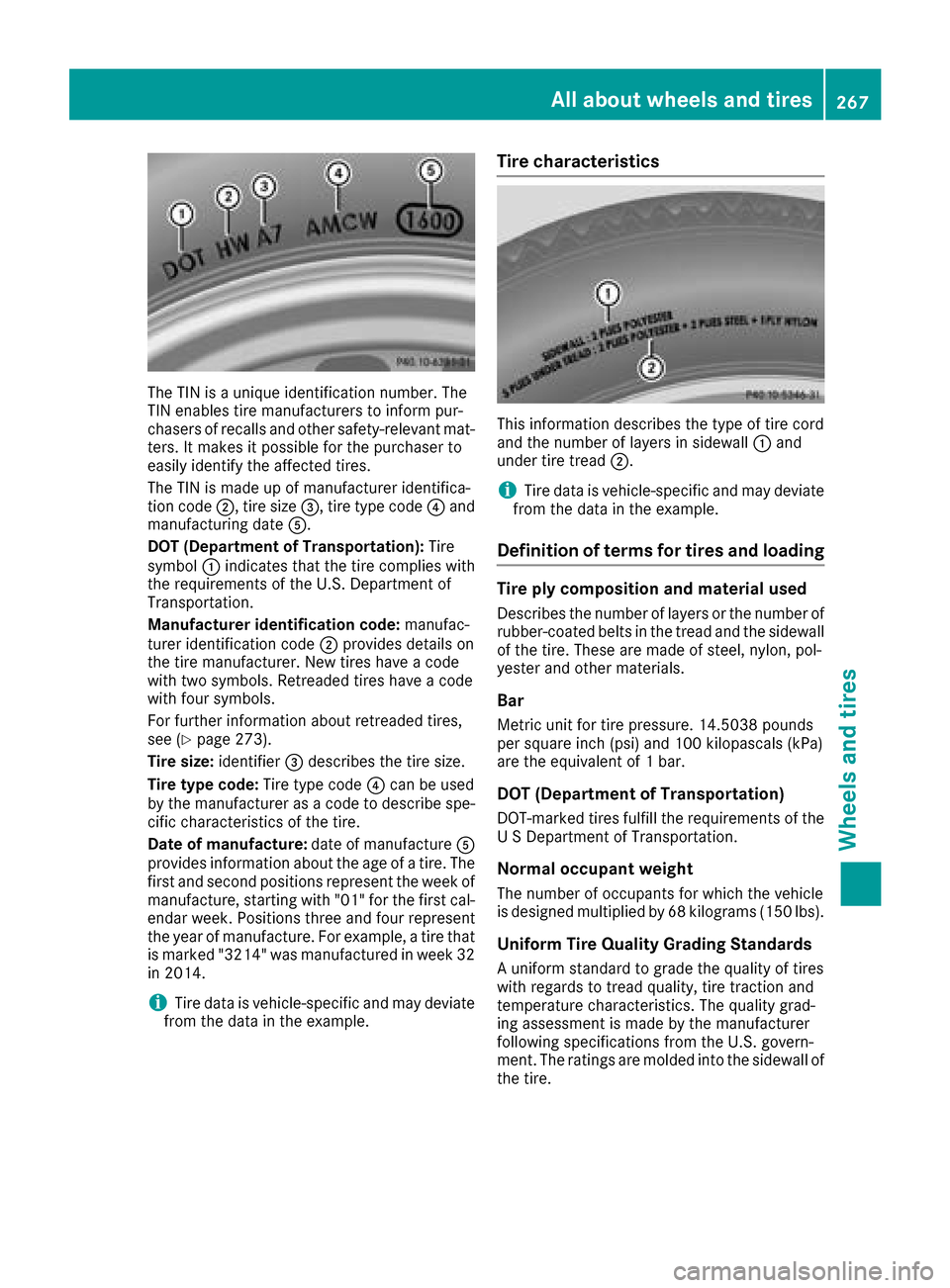
The TIN isaunique identification number. The
TIN enables tire manufacturers to inform pur-
chasers of recalls and other safety-relevan tmat-
ters. It makes it possible for the purchaser to
easily identify the affected tires.
The TIN is made up of manufacturer identifica-
tion code ;,tire size =,tire type code ?and
manufacturing date A.
DOT (Department of Transportation): Tire
symbol :indicates that the tire complies with
the requirementsoft he U.S. Department of
Transportation.
Manufacturer identification code: manufac-
turer identification code ;provides details on
the tire manufacturer. New tires have acode
with two symbols. Retreaded tires have acode
with four symbols.
For further information about retreaded tires,
see (
Ypage 273).
Tire size: identifier=describes the tire size.
Tire typec ode:Tire type code ?can be used
by the manufacturer as acode to describe spe-
cific characteristics of the tire.
Date of manufacture: date of manufactureA
provides information about the age of atire. The
first and second positions represent the week of
manufacture, starting with "01" for the first cal-
endar week. Positions three and four represent
the year of manufacture. For example, atire that
is marked "3214" was manufactured in week 32
in 2014.
iTire data is vehicle-specific and may deviate
from the data in the example.
Tire characteristics
This information describes the type of tire cord
and the number of layers in sidewall :and
under tire tread ;.
iTire data is vehicle-specific and may deviate
from the data in the example.
Definition of term sfor tires and loading
Tire ply composition and material used
Describes the number of layers or the number of
rubber-coated belts in the tread and the sidewall
of the tire. These are made of steel, nylon, pol-
yester and other materials.
Bar
Metric unit for tire pressure. 14.5038 pounds
per square inch (psi) and 100 kilopascals (kPa)
are the equivalent of 1bar.
DOT (Department of Transportation)
DOT-marked tires fulfill the requirementsoft he
USD epartment of Transportation.
Normal occupant weight
The number of occupantsf or which the vehicle
is designed multiplied by 68 kilograms (150 lbs).
Uniform Tire Quality Grading Standards
Au niform standard to grade the quality of tires
with regards to tread quality, tire traction and
temperature characteristics. The quality grad-
ing assessment is made by the manufacturer
following specification sfrom the U.S. govern-
ment.T he ratings are molded into the sidewall of
the tire.
All about wheelsa nd tires267
Wheels and tires
Z
Page 270 of 286
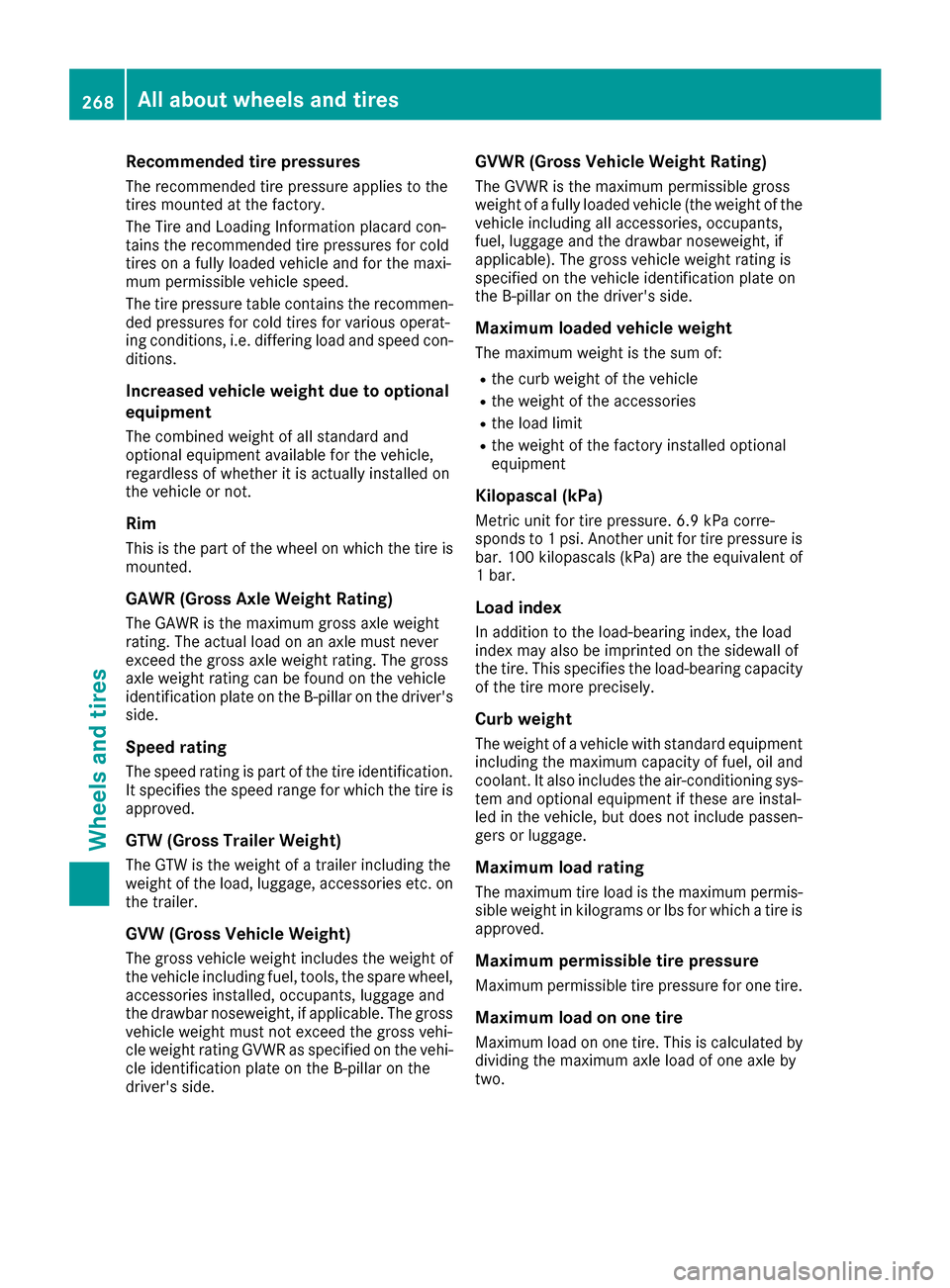
Recommendedtire pressures
The recommended tire pressure applie stothe
tire sm ounted at the factory.
The Tir eand Loading Information placard con-
tains the recommended tire pressures for cold
tire sonaf ully loaded vehicle and for the maxi-
mum permissible vehicle speed.
The tire pressure table contains the recommen- ded pressures for coldt iresfor variou soperat-
ing conditions ,i.e .d iffering loa dand speed con-
ditions.
Increasedv ehicle weight due to optional
equipment
The combined weigh tofallstandard and
optionale quipment available for the vehicle,
regardless of whether it is actually installed on
the vehicle or not.
Rim
Thisist he part of the wheel on which the tire is
mounted.
GAW R(Gross Axle Weight Rating)
The GAW Risthe maximum grossa xlew eight
rating. The actual loa donanaxlem ustn ever
excee dthe grossa xlew eigh trating. The gross
axl ew eigh trating can be found on the vehicle
identification plate on the B-pillar on the driver's
side.
Speed rating
The speed rating is part of the tire identification. It specifies the speed rang efor which the tire is
approved.
GTW (Gross Trailer Weight)
The GT Wisthe weigh tofatraile rincluding the
weigh tofthe load, luggage, accessorie setc. on
the trailer.
GVW (Gross Vehicl eWeight)
The grossv ehicle weigh tincludes the weigh tof
the vehicle including fuel, tools, the spare wheel,
accessorie sinstalled, occupants, luggage and
the drawbar noseweight, if applicable. The gross
vehicle weigh tmustn ot excee dthe grossv ehi-
cle weigh trating GVW Rasspecified on the vehi-
cle identification plate on the B-pillar on the
driver'ss ide.
GVWR (Gross Vehicl eWeight Rating)
The GVW Risthe maximum permissible gross
weigh tofafully loaded vehicle (the weigh tofthe
vehicle including al laccessories, occupants,
fuel, luggage and the drawbar noseweight, if
applicable). The grossv ehicle weightrating is
specified on the vehicle identification plate on
the B-pillar on the driver'ss ide.
Maximum loaded vehicle weight
The maximum weightist he sumo f:
Rthe curb weigh tofthe vehicle
Rthe weigh tofthe accessories
Rthe loa dlim it
Rthe weigh tofthe factory installed optional
equipment
Kilopascal (kPa)
Metricu nitf or tire pressure. 6.9 kPa corre-
sponds to 1psi.A nother uni tfor tire pressure is
bar. 100 kilopascals (kPa )are the equivalent of
1b ar.
Load index
In addition to the load-bearing index, the load
index may also be imprinte donthe sidewal lof
the tire .Thiss pecifies the load-bearing capacity
of the tire more precisely.
Curb weight
The weigh tofavehicle with standard equipment
incl uding the maximum capacity of fuel, oil and
coolant. It also includes the air-conditioning sys-
tem and optionale quipment if thesea re instal-
le dint he vehicle ,but doe snot includ epassen-
ger sorl uggage.
Maximum load rating
The maximum tire loa disthe maximum permis-
sible weigh tinkilograms or lb sfor which atire is
approved.
Maximum permissiblet ire pressure
Maximumpermissible tire pressure for one tire.
Maximum load on on etire
Maximu mloadono ne tire .Thisisc alculate dby
dividing the maximum axl eloa dofo ne axl eby
two.
268Al la bout wheels and tires
Wheels and tires
Page 271 of 286
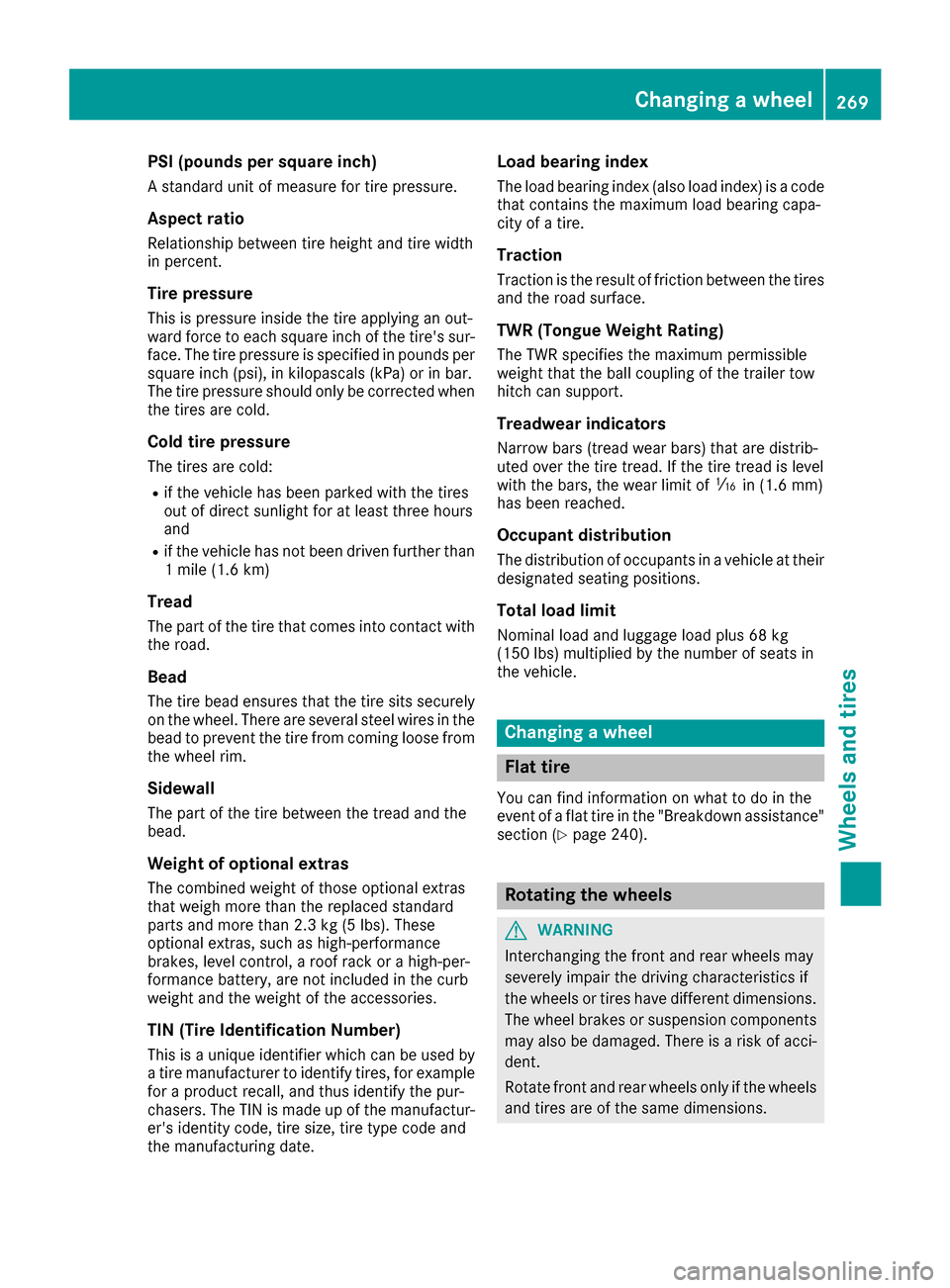
PSI (pounds per squareinch)
Astandard unit of measure for tire pressure.
Aspect ratio
Relationship between tire height and tire width
in percent.
Tire pressure
This is pressure inside the tire applying an out-
ward force to each square inch of the tire's sur-
face. The tire pressure is specified in pounds per
square inch (psi), in kilopascals (kPa) or in bar.
The tire pressure should only be corrected when
the tires are cold.
Cold tire pressure
The tires are cold:
Rif the vehicle has been parked with the tires
out of direct sunlight for at least three hours
and
Rif the vehicle has not been driven further than
1m ile (1.6 km)
Tread
The part of the tire that comes into contact with
the road.
Bead
The tire bead ensures that the tire sits securely
on the wheel. There are several steel wires in the
bead to prevent the tire from coming loose from
the wheel rim.
Sidewall
The part of the tire between the tread and the
bead.
Weight of optional extras
The combined weight of those optional extras
that weigh more than the replaced standard
parts and more than 2.3 kg (5 lbs). These
optional extras, such as high-performance
brakes, level control, aroof rack or ahigh-per-
formanceb attery, are not included in the curb
weight and the weight of the accessories.
TIN (Tire Identification Number)
This is aunique identifier which can be used by
at ire manufacturer to identify tires, for example
for aproduct recall, and thus identify the pur-
chasers. The TIN is made up of the manufactur-
er's identity code, tire size, tire type code and
the manufacturing date.
Load bearing index
The load bearing index (also load index) is acode
that contains the maximum load bearing capa-
city of atire.
Traction
Traction is the result of friction between the tires
and the road surface.
TWR (Tongue Weight Rating)
The TWR specifies the maximum permissible
weight that the ball coupling of the trailer tow
hitch can support.
Treadwear indicators
Narrow bars (tread wear bars) that are distrib-
uted over the tire tread. If the tire tread is level
with the bars, the wear limit of áin (1.6 mm)
has been reached.
Occupant distribution
The distribution of occupants in avehicle at their
designated seating positions.
Total load limit
Nominal load and luggage load plus 68 kg
(150 lbs) multiplied by the number of seats in
the vehicle.
Changing awheel
Flat tire
You can find information on what to do in the
event of aflat tire in the "Breakdown assistance"
section (
Ypage 240).
Rotating the wheels
GWARNING
Interchanging the front and rear wheels may
severely impair the driving characteristics if
the wheels or tires have different dimensions. The wheel brakes or suspension components
may also be damaged. There is arisk of acci-
dent.
Rotate front and rear wheels only if the wheels and tires are of the same dimensions.
Changing awheel269
Wheels and tires
Z